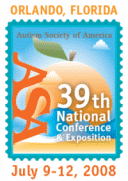 |
The ASA's 39th National Conference on Autism Spectrum Disorders of ASAThe Westin Kierland Resort & Spa, Scottsdale, AZ |
| For a complete author index with session numbers, please click here | |
| Thursday, July 10, 2008: 2:15 PM-3:30 PM | |||
| Sanibel 1 | |||
| #3383- Autism and AAC (Augmentative and Alternative Communication) | |||
| Extensive debate surrounds communication intervention strategies for young children with autism. Case examples and extensive vidoe will demonstrate how natural teaching techniques, functional language teaching, social interaction, internal motivation and emotional regulation play key roles in the development of communication for children with autism. Additionally, research demonstrating that literacy learning significantly impacts language learning as well as reciprocity, engagement, focus and attending will be highlighted. This session will highlight both high tech (tango!)and low tech AAC intevention strategies. | |||
| Presenters: | - Pati King-DeBaun is a speech language pathologist specializing in communication for children who struggle to communicate. She is adjunct professor at the University of Utah Special Education Department. Pati has published and speaks/consults on interactive communication, augmentative communication, and early literacy for children with severe disabilities.
- Susan Norwell, who has a master's in Special Education, has worked with students with autism for the last 31 years. She considers herself a relationship-based educational specialist and has focused in the recent past on augmentative communication, play and literacy for children on the spectrum, especially those without verbal language. | ||
|
| |||
|
There is a considerable amount of debate on how to develop communication and/or intervention strategies for young communicators with complex communication needs. For children with autism this debate is as multifaceted as the diagnosis itself. This session will demonstrate through case examples how natural teaching techniques, functional language teaching, social interaction ,internal motivation and emotional regulation play a key role in the development of communication for children with autism. In addition, significant research demonstrating that literacy learning significantly impacts language learning as well as intangibles such as reciprocity, engagement, focus and attending will be highlighted. This session will demonstrate case examples of success strategies for developing communication and intervention for children with autism. This session will highlight light technology AAC and high technology( the tango!). communication and/or intervention strategies for young communicators. Case examples, hands on materials, and extensive video examples will be a part of this session. Children presented will include those at the severe end of the spectrum that are often overlooked for AAC consideration and present with the greatest behavioral and learning challenges. Delprato’s (2001) comparison of 10 studies involving discrete-trail training and normalized behavioral language interventions for young children yielded evidence overwhelmingly in favor of more normalized methods of loosely structured instructional sessions in natural situations following the child’s initiation. Yet despite this research, children with autism are often taught within ABA programs that yield marginal results in terms of language development and social interaction and reciprocity. AAC instruction and training for children with autism has traditionally utilized a non-interactive, stimulus response training methodology (Buekelman & Mirenda, 1992; Goosens’, Crain & Elder, 1992). Buekelman and Mirenda have proposed that the ineffective use of AAC by users is the result of limited opportunities for learning within a natural and functional context. Thus it seems reasonable to question the strategies and settings utilized to teach young children with autism the very skills that are the core deficits of the diagnosis itself. It also seems imperative to question the organization of AAC systems that emphasize this same form over function. |
|||
See more of General Submissions
See more of The ASA's 39th National Conference on Autism Spectrum Disorders